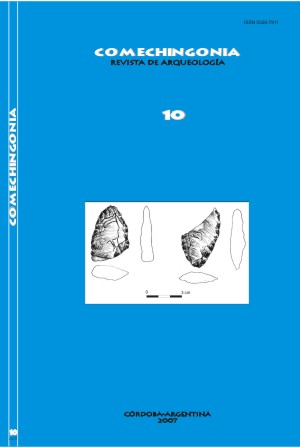DIET AND AGROPASTORILE COMPANIES: ANALYSIS OF STABLE ISOTOPES OF A SITE OF THE ARGENTINE SOUTHERN PUNA (ANTOFAGASTA DE LA SIERRA, CATAMARCA)
Main Article Content
Abstract
In this paper we present the results of carbon, nitrogen and sulfur stable isotope analysis perfonned on human (hair and nail) and animal (camelid fibers) samples. 'The sampled materials come from a funerary context associated to an agropastoralist settlement (Punta de la Peña 9), located in Antofagasta de la Sierra (Catamarca),in the Southern Puna of Argentina. The results are discussed considering the whole contextual evidence recovered at the site as well as the available models about the subsistente strategies implemented by prehistoric populations of the orea at ca. 1500 years B.P. In addition to propositions about the incidente of agricultural products (e.g. maize) on the human diet, we propone that stable isotope analysis of animal samples constitutes a complementaty and valuable line of inquiry about archaeological issues that go beyond strict paleodietary information. Among such issues are the complex and multivariate process of camelid domestication in the South Andean Area and/or with the specific strategies deployed by agropastoral activity at the regional level.
Downloads
Article Details
Copyleft
Este obra está bajo una licencia de Creative Commons Reconocimiento-CompartirIgual 4.0 Internacional.
Usted es libre para: Compartir — copiar y redistribuir el material en cualquier medio o formato
- Adaptar — remezclar, transformar y crear a partir del material
- Para cualquier propósito, incluso comercialmente
- El licenciante no puede revocar estas libertades en tanto usted siga los términos de la licencia
-
Atribución — Usted debe darle crédito a esta obra de manera adecuada, proporcionando un enlace a la licencia, e indicando si se han realizado cambios. Puede hacerlo en cualquier forma razonable, pero no de forma tal que sugiera que usted o su uso tienen el apoyo del licenciante.
-
CompartirIgual — Si usted mezcla, transforma o crea nuevo material a partir de esta obra, usted podrá distribuir su contribución siempre que utilice la misma licencia que la obra original.
- No hay restricciones adicionales — Usted no puede aplicar términos legales ni medidas tecnológicas que restrinjan legalmente a otros hacer cualquier uso permitido por la licencia.
Copyrigth
Si bien los derechos de autor de los artículos son de los mismos autores; el titular del copyrigth es la Revista Comechingonia.
Esto estará indicado en cada artículo, asi como la licencia Copyleft anteriormente descrita.




